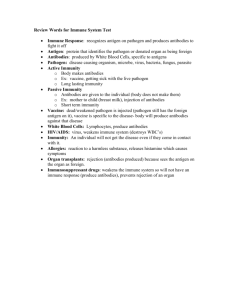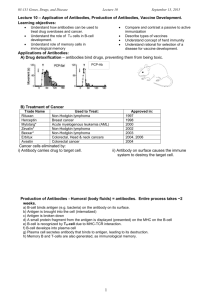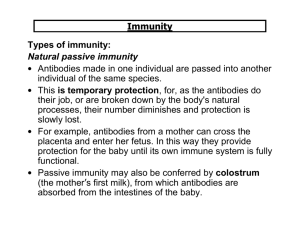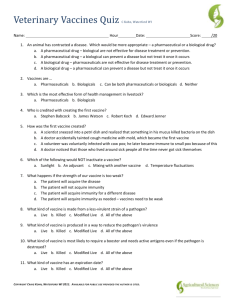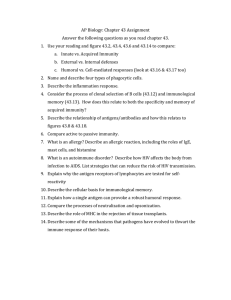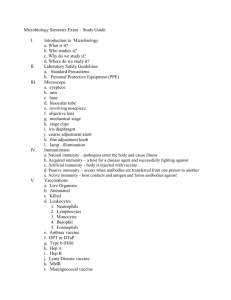Veterinary Vaccines & Biologicals
advertisement
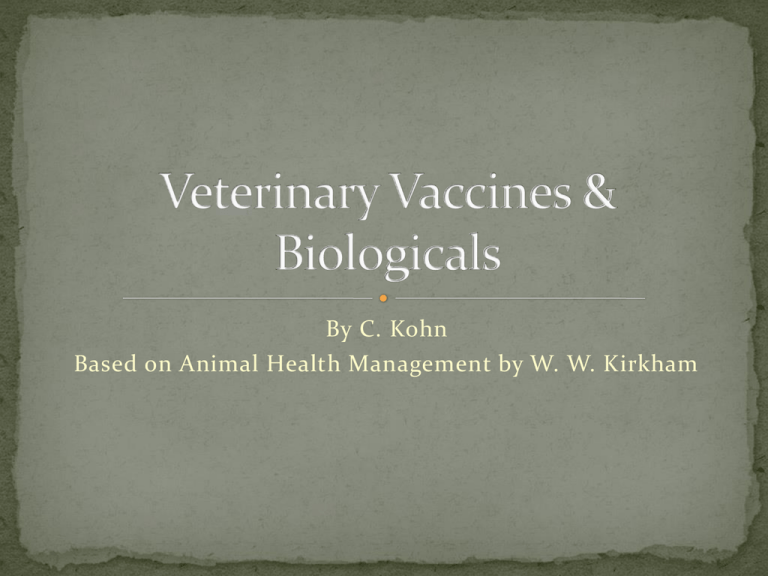
By C. Kohn Based on Animal Health Management by W. W. Kirkham Drugs used by veterinarians are classified as either pharmaceuticals or biologicals. Pharmaceuticals are use mainly for the treatment of a disease Biologicals are used mainly for the prevention of a disease Biologicals are used to stimulate immunity against specific diseases They provide the most reliable and effective form of livestock health management. Edward Jenner, an English physician, is credited for discovering the first vaccine in 1796 Dr. Jenner recognized that farmers who had been exposed to cowpox were not susceptible to the much more serious human smallpox Dr. Jenner inoculated a human volunteer with pus from the sores of a cow with cow pox The volunteer developed localized sores at the site of inoculation Months later, the volunteer was inoculated to with small pox. The subject did no develop any symptoms from this exposure. The antigens produced from cow pox were similar enough to prevent a small pox infection. Biologicals are effective in preventing disease because they cause an “antigen-antibody” reaction in the animal’s body An antibody is a protein produced by the body of the animal to fight an invading pathogen An antigen is the invading pathogen Antigen is shorthand for “Antibody Generator” A biological vaccine works by giving the animal weakened or killed antigens The immune system responds by “remembering” the disease so that it can recognize it if it invades again Vaccines are highly sensitive medicines This is largely because they contain living material that must be kept at a weakened state but also be kept alive enough to generate an antibody-response in the animal Vaccines can be rendered ineffective by… Sunlight Temperature fluctuations Mixing with other vaccines Use after an expiration date Purchasing from a disreputable dealer Vaccines are tricky in that we want to balance virulence of the bacteria with antibody generation potential of the vaccine In other words, we want the vaccine to be strong enough to generate immunity in the host animal However, we don’t want the vaccine to be so strong that it actually causes the disease in the animal! Too weak of a vaccine = no immunity Too strong of a vaccine = catching the disease you want to prevent Vaccine means “any biological agent that produces active immunity” Active immunity is long term immunity created by the animal itself, as opposed to short-term passive immunity from milk or blood transfusion There are three categories of vaccine: Live Killed Modified Live Live Vaccines: a less-virulent version of a pathogen (e.g. Cowpox vs. Smallpox) Advantage – effective in creating immunity Disadvantage – not all pathogens have a less-virulent version Killed Vaccine: a pathogen that has completely been killed but whose antigens remain active (e.g. Bacterin) Advantage – there is no risk of a disease from the vaccine because the pathogen is killed Disadvantage – not as effective as a live vaccine; usually requires a booster Modified Live : a pathogen that is grown in a manner to reduce its virulence It’s the live, virulent pathogen, but changed and less pathogenic. An antiserum is a blood serum containing specific antibodies against a disease; it is obtained from an animal that has been immunized against a disease Antiserums are considered a form a passive immunity They are short term and do not require an immune response from the infected animal Antitoxins are antiserums that contain antibodies to bacterial toxins Tetanus antitoxin is a prime example A tetanus antitoxin antiserum helps an animal overcome both the tetanus infection as well as the effects of the exotoxin produce by the tetanus bacteria Toxoids are detoxified toxins that are used as antigens Adjuvants are substances added to biologicals to enhance the antigen’s ability to stimulate antibody production Adjuvants perform this enhancement by delaying the absorption of the antigen Adjuvants also increase effectiveness of the biological by stimulating the immune system to respond with greater force to the antigen in the biological By C. Kohn Based on Intro. To Veterinary Science, Lawhead & Baker When an animal is first exposed to an antigen, it takes 3-14 days for a significant amount of antibody to be produced. This is called the Primary Response A pathogen has numerous binding sites on its surface Y-shaped antibodies will bind to these surfaces They will then stimulate the phagocytic cells that digest the pathogen or can even inactive the pathogen through their binding to its surface For example, an antibody-coated virus is incapable of attacking other cells Antigen Antibody During the initial production of antibodies, some antibody-producing cells slow down their production Instead of producing short-lived antibodies to fight the pathogen, they produce smaller amounts of longlived memory cells. These cells are able to provide a much quicker response the next time the body is exposed to the same pathogen With the presence of memory cells, much less antigen is required to stimulate the reaction by the immune system This results in a quicker response time and a larger production of antibody The quicker, larger production of antibodies due to the memory cell activity is known as the Secondary Response The Secondary Response prevents the animal from developing the disease the second time. The memory cells that enable the Secondary Response to occur originate from the B- and T-Lymphocytes (the predator cells that kill pathogenic bacteria and viruses). Reminder – Primary & Secondary Responses are part of Active Immunity – the body is producing its own response Passive Immunity would be from a transfer of blood or milk from an immune animal to a non-immune animal Passive is short-term immunity By C. Kohn Based on Animal Health Management by W. W. Kirkham Injection requires a sterile technique Care must be taken to prep the injection site, equipment, and product to minimize complications Needles come in many diameters and variable lengths 22 gauge 1 inch and 18 gauge 1.5 inch needles are adequate for most injections in livestock To fill a syringe – Pull back on the plunger and fill the syringe with an amount of air equal to the amount of medication to be placed in the syringe 2. Wipe the rubber stopper of the medicine bottle with rubbing alcohol 3. Pass the needle through the rubber stopper and slowly inject the air into the bottle 1. 4. Holding the bottle upside down, make certain that only the bevel of the needle is through the stopper (so that you can remove the last of the drug from the bottle) 5. Remove all air bubbles from the syringe by tapping with your finger and allowing adequate time for air bubbles to move upward. 6. Pull the desired amount of product into the syringe 7. Pull the needle straight out to remove it from the stopper. Be sure to avoid contaminating the needle. Alcohol is a poor disinfectant and requires several minutes to be effective against the bacteria it is killing Be sure to remove mud and manure from the injection site using soap and water Rinse the site and dry it prior to the injection and after the treatment of soap and water It is not necessary to clip or shave the injection site After the injection, make sure that the injected material does not leak from the opening in the skin when the needle is removed. If it occurs, hold your finger over the injection site and pinch firmly for a few seconds. Intramuscular – into the muscle Subcutaneous – beneath the skin Intravenous - into a vein Intradermal – between the layers of skin Intraperitoneal - into the lumen of the intestines Intramammary – into the udder through the teat cistern via a cannula (hollow tube for injections) Subconjunctival - beneath the conjunctiva (outer layer) of the eye Nebulization/Inhalation - administration via inhaling

